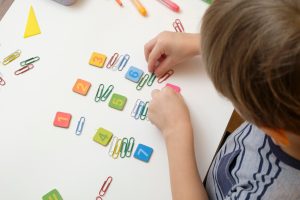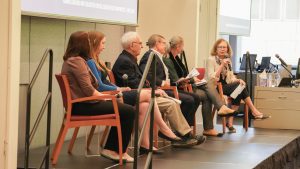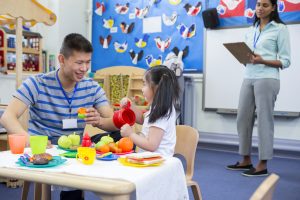- Efforts to encourage young children’s learning about math at home have been gaining momentum. These efforts are part of an emerging field called family math.
- Parent and caregiver attitudes and beliefs about math are important to consider when developing family math programs.
- Research must recognize social and cultural differences in how families engage in math.
Research has shown that early math skills prepare young children for success in school and in life. Research has also shown that, concerningly, gaps in children’s math knowledge can start as early as preschool. A number of efforts are underway to explore the role that families can play in closing this gap. One way is by supporting children’s earliest math experiences—both their growing math skills and their enthusiasm about doing math—at home and in communities.
As general interest in supporting young children’s math learning is growing, we have also seen growth in research to understand, and efforts to support, families’ engagement in early math. These efforts are at the heart of the growing family math movement, which aims to engage parents and caregivers in children’s early math learning outside the classroom. Family math focuses on math in everyday life, from sorting laundry and measuring ingredients to finding things in different shapes and sizes. It also involves conversations and play activities that build children’s comfort with math.
Although the ways that families engage with math differ depending on culture and parents’ own experiences, all families engage with math in daily life. By building on what families are already doing, researchers and educators are developing ways to understand and support more engagement. Their focus is to provide families with the resources and knowledge they need to find, talk, and learn about math together. The larger goals are to build awareness and a set of best practices around family math.
On Paper and Practice, Growing the Field of Family Math
To keep up the momentum, it’s important to understand the current state of family math engagement with a wide lens. What can current research and practice tell us about what is known and where further study is needed? What programs and strategies seem to work, and where should we direct future efforts?
We conducted a review of the current research as part of an initiative of the Family Math Roadmap Implementation Project, a network of early childhood researchers, advocates, community leaders, and philanthropists. We also interviewed educators and neighborhood practitioners working with families. This combination of information helped us come to several key conclusions about family math, including:
Family math needs to go beyond counting and numbers.
Both researchers and practitioners said we need to encourage young children to explore not only numbers, but also other key early math concepts, to promote later math success. In particular, children need to understand how to identify and continue patterns. They also need to build their spatial thinking, an early math skill that involves understanding how things change when moved or rotated. Research shows that It is important for family math programs and resources to help families explore a broad range of math concepts.
Positive attitudes about math are just as important as math knowledge.
Many studies have shown that caregivers who set high expectations for their children’s math success—and who value and enjoy math themselves—can affect their children’s math achievement as well as how they feel toward math. Practitioners also described how caregivers’ own math anxiety and negative experiences with math may reduce how much they talk about math with their children. Promoting positive attitudes about math is critical to promoting family math.
Access to resources and support needs to be available for all families.
Research shows that children from families with fewer resources may especially benefit from high-quality family math engagement. Yet practitioners observed how some of the best resources and programs for family math are not accessible to all families due to cost, technological requirements, language barriers, demands on time, or transportation issues linked to location of the resources. Family math support needs to be equitable and inclusive.
What Challenges Need More Study?
More work is needed to represent all families.
Information is limited about how families of color, families with different cultural backgrounds, and families from lower socioeconomic backgrounds engage in math at home. The surveys and methods used by researchers to measure family math engagement may overlook valuable and culturally specific practices that support young children’s math learning. Family math programs need to build on what families are already doing together to promote their children’s early math development.
More research is needed around materials that help with learning.
Studies have shown that certain materials, such as books, games, and apps, can both increase family engagement in math and improve children’s math knowledge. These materials fall under a broad category of education interventions—special steps designed to help children improve in their area of need. Research on this topic is still relatively new, however, and it will be critical for additional work to look at long-term outcomes of family math interventions. Researchers also need to explore how to scale up and bring interventions to a large audience.
Growing Family Math Through Practice, Policy, and Research
Based on our review, we proposed a set of recommendations to move family math efforts forward with regard to practice, policy, and research. Some highlights from our recommendations:
For Practice:
- Make it easier for peers to learn from one another. Schools and other local organizations can recruit family members to be “parent ambassadors” where caregivers can connect with each other and share math activities their own families enjoy.
- Build on high expectations. All caregivers want their children to succeed! Schools can communicate how children’s earliest experiences with math can build a strong foundation for their later school achievement.
- Team up with fellow community-based partners. Schools and other neighborhood settings can help one another with knowledge, space, and relationships with families within a community. By coordinating and pooling resources, schools and community centers may be able to offer events with greater reach and impact.
For Policy:
- To align math at home and school, add family engagement to the school curriculum. Lesson plans can include flexible, open-ended activities that reinforce math content taught at school in ways that caregivers can adapt to suit their own families’ practices and interests.
- Support efforts that consider communities’ unique contributions and needs. The places and spaces where families spend time and interact with their community provide great opportunities to tailor family math efforts that are accessible and relevant.
- Offer more resources and events to underserved families. Events and installations that are low- or no-cost for families can be placed in underserved communities. It is also critical to consider the technology, language, and literacy demands of resources, and adaptations that are usable for all families.
For Research:
- Address math attitudes as part of intervention work. Since expectations and attitudes can have big impacts on math achievement, research should examine how interventions can also reduce caregivers’ math anxiety or promote positive attitudes about math.
- Collaborate with families and practitioners, and use open-ended research methods to broaden the concept of family math. In order to build on what families are already doing, we need to increase our understanding of what family math looks like in diverse cultural and socioeconomic settings. By partnering with practitioners, and building on strengths of what families are already doing, this work is much more likely to be successful.
- Follow interventions over time and across larger samples. It is unclear whether short-term effects from brief interventions will continue to influence family math engagement or children’s math outcomes. It will be important to understand what it takes to sustain the positive effects of interventions in order to determine what approaches have the most lasting effects.
If you are interested in learning more about our conclusions and recommendations, check out the summary or read the full review.
DREME promotes family engagement around early math by offering free, research-based materials for professionals who work with families with young children. Explore activities and ideas for supporting family math on the DREME Family Math website.
This work was funded by the Family Math Roadmap Implementation Project, supported by the Heising-Simons Foundation. The authors wish to thank the practitioners who participated in interviews to discuss family math and provide feedback regarding our recommendations.



